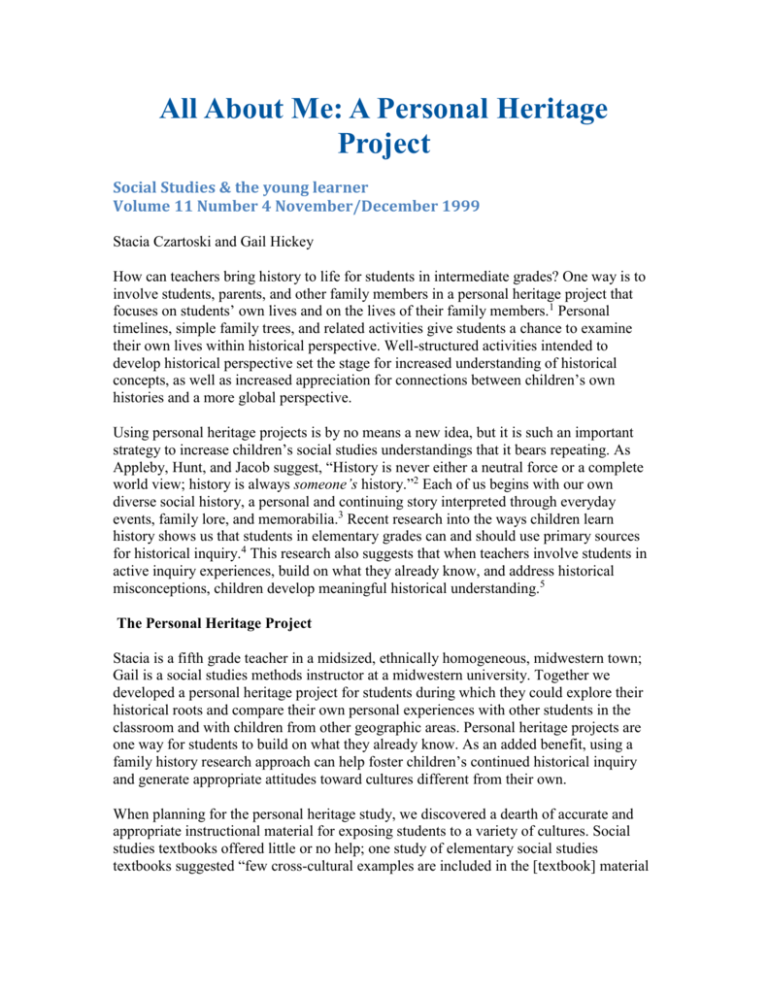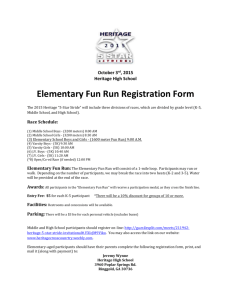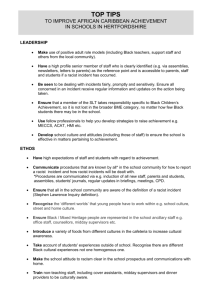
All About Me: A Personal Heritage
Project
Social Studies & the young learner
Volume 11 Number 4 November/December 1999
Stacia Czartoski and Gail Hickey
How can teachers bring history to life for students in intermediate grades? One way is to
involve students, parents, and other family members in a personal heritage project that
focuses on students’ own lives and on the lives of their family members.1 Personal
timelines, simple family trees, and related activities give students a chance to examine
their own lives within historical perspective. Well-structured activities intended to
develop historical perspective set the stage for increased understanding of historical
concepts, as well as increased appreciation for connections between children’s own
histories and a more global perspective.
Using personal heritage projects is by no means a new idea, but it is such an important
strategy to increase children’s social studies understandings that it bears repeating. As
Appleby, Hunt, and Jacob suggest, “History is never either a neutral force or a complete
world view; history is always someone’s history.”2 Each of us begins with our own
diverse social history, a personal and continuing story interpreted through everyday
events, family lore, and memorabilia.3 Recent research into the ways children learn
history shows us that students in elementary grades can and should use primary sources
for historical inquiry.4 This research also suggests that when teachers involve students in
active inquiry experiences, build on what they already know, and address historical
misconceptions, children develop meaningful historical understanding.5
The Personal Heritage Project
Stacia is a fifth grade teacher in a midsized, ethnically homogeneous, midwestern town;
Gail is a social studies methods instructor at a midwestern university. Together we
developed a personal heritage project for students during which they could explore their
historical roots and compare their own personal experiences with other students in the
classroom and with children from other geographic areas. Personal heritage projects are
one way for students to build on what they already know. As an added benefit, using a
family history research approach can help foster children’s continued historical inquiry
and generate appropriate attitudes toward cultures different from their own.
When planning for the personal heritage study, we discovered a dearth of accurate and
appropriate instructional material for exposing students to a variety of cultures. Social
studies textbooks offered little or no help; one study of elementary social studies
textbooks suggested “few cross-cultural examples are included in the [textbook] material
on families, neighborhoods, and communities, and the world geography [content] focuses
on places more than on cultures.”6
A personal heritage project provided opportunities for students to explore the following
themes of the social studies standards: 1 Culture; 2 Time, Continuity, and Change; and 4
Individual Development and Identity.7 As we implemented the project, we kept in mind
that at the fifth grade level, students should be involved in activities and experiences
about culture to help them
compare similarities and differences in the ways groups, societies, and cultures meet
human needs and concerns
Explain how information and experiences may be interpreted by people from
diverse cultural perspectives and frames of reference
Explain why individuals and groups respond differently to their physical and
social environments and/or changes to them on the basis of shared assumptions,
values, and beliefs
Activities dealing with time, continuity, and change should promote students’ abilities to
Identify and use key concepts such as chronology, causality, change, conflict, and
complexity to explain, analyze, and show connections among patterns of
historical change and continuity
Identify and describe selected historical periods and patterns of change within and
across cultures
Develop critical sensitivities such as empathy and skepticism regarding attitudes,
values, and behaviors of people in different historical contexts
And experiences concerning individual development and identity should lead students to
Relate personal changes to social, cultural, and historical contexts
Describe personal connections to place
Describe the ways family, gender, ethnicity, nationality, and institutional
affiliations contribute to personal identity
Identify and describe ways the influence of perception, attitudes, values, and
beliefs on personal identity
Work independently and cooperatively to accomplish goals 8
To initiate the family heritage study, we shared the book People.9 It depicts photographs
of people from all around the world and tells about their belief structures and everyday
living practices. A paragraph from Stacia’s reflective journal describes what happened as
she shared People with her fifth grade students:
We talked about how people look, act, feel, and believe similarly to and differently from
each of us. Traditions, customs, beliefs, and cultures covered in the book that are
unfamiliar to students’ experiences were discussed; I stressed that we may not understand
or agree with others, but we need to be sensitive to and respectful of their beliefs. This
led students to the idea that the more we know about others’ beliefs and cultures, the
more prepared we will become to appreciate differences as well as similarities.
The students were cautiously curious about other people’s cultures and beliefs, as many
had never seen or experienced firsthand cultures beyond their hometown. Some student
comments, however, were critical, even negative, about the diverse cultures depicted in
the book. Stacia realized the students were critical of appearances, skin colors, clothing,
beliefs, and customs different from their own as a result of their lack of exposure to
others unlike themselves. As a way of counteracting students’ stereotypes, we decided to
provide students with many opportunities, especially through the use of children’s
literature, to learn about the diversity in every classroom and every community, no matter
how homogeneous the population may be.
As the unit of study was explained to the students, they were encouraged to learn about
their personal heritage and to complete a family history book. The completed book would
contain their autobiography from birth to fifth grade, information about family and
cultural heritage, and photographs. Students were experienced in process writing and
somewhat accustomed to authoring books in the classroom setting.
Interest and learning centers were set up where students could investigate, read about,
and engage in cultural heritage activities. During the next two weeks, as students read
related books and worked at centers, they brought in photographs of themselves and other
family members, baby books or memory books about themselves borrowed from their
parents or grandparents, and copies of personal documents such as birth certificates or
letters. They asked family members questions, and researched at home to discover what
their likes and dislikes had been since babyhood (and how these had changed over time).
They also found out many things about their families’ histories they had not known
before, such as anecdotes or stories from the oral tradition that had never been written
down.
When students began to create their personal heritage books, they were asked to draw
themselves as they would like to be represented and to draw their families. One of the
first representations of diversity came when a few students asked what a family is. “We
had an interesting discussion,” Stacia says. “Students determined that, for them, a family
is who you think is in your family.” One student who had three step-dads and numerous
step sisters wanted them all to be in his family picture. We found it was important to be
open and embracing of each student’s individual interpretation of family—even to
including pets as family members!
Another part of the family heritage exploration included research about various types of
shelter. Students included a representation of their homes in their personal heritage
books. They could either draw or prepare a photograph of the exterior of their home, or
represent the interior in blueprint style. This option permitted students to prepare a visual
of their home without enduring teasing or negative comparisons among peers.
Students were encouraged to conduct personal family research and to complete a family
tree. Help with details, such as names and dates, was sought from parents and other
family members. All students were encouraged to research their ancestry as far back as
possible, and to include themselves, their parents, and their grandparents. We found that
many students wanted to research family trees even farther back, including greatgrandparents and aunts and uncles.
Photographs from students’ pasts were brought in and studied. Each student brought in
four or five favorite photographs to be scanned into the classroom computer. When the
scanned photos were printed, each student arranged his/her photo display, and labeled
each picture to represent events from the past. Students could also opt to illustrate with
drawings or magazine pictures.
Finally, students wrote an autobiography for their personal heritage books. They were
encouraged to write or telephone grandparents and other relatives in order to collect
information about their early years for use when writing their autobiographies. If parents
kept baby books during students’ first year or two of life, students were encouraged to
record what they found out about themselves by reading their own baby books.
Guidelines for writing autobiographies included memories and facts surrounding
students’ first years of life, their most memorable or most embarrassing experience,
hobbies, places they have visited while traveling or on class field trips, and plans for the
future.
After students finished the first draft of their autobiographies, they paired up to proofread
each other’s writing. This experience allowed them to transfer what they had learned
about process writing to writing about historical events. Sharing their autobiographies
with one another allowed students to compare and contrast their own life stories with
those of their classmates. The fifth graders were amazed at what they did or said when
they were a certain age. We found that students tended to compare what they did at a
certain age, such as getting their first tooth or learning to ride a bicycle, to the age when
their friends and other classmates first did these things. Students were able to see
personal similarities and differences, giving them another experience with diversity.
As a culminating activity, students shared and read aloud highlights of their lives and
favorite parts of their books. This led to a discussion of likenesses and differences in
family units, homes, childhood and family experiences, beliefs and values, and long-term
goals. Students began to understand that diversity is all around them. We noticed as well
a slowly changing attitude about other cultures and ethnic groups among the students
after this assignment. Students displayed their books in the classroom to allow other
students to examine them. They concluded that the project was a lot of work, but worth it.
Teachers who wish to try a similar project with their students might consider stimulating
students’ interest in learning about the history behind their early years by creating a
bulletin board display of “baby photographs”—have students bring a photo or snapshot of
themselves as a baby or toddler and, after arranging these photos on the bulletin board,
have students try to guess “who’s who.” This activity will lead to “remember when”
kinds of discussions, which should motivate students to more thoroughly research their
own backgrounds.
Activities, Bulletin Board, and Learning Center Ideas
While students worked on their personal heritage books, other related activities and
experiences were planned to facilitate their study and to fulfill social studies curricular
themes. Some of these activities included the following:
Collect postcards from throughout the world and display them on a world map.
Collect family photographs and find family pictures from magazines like National
Geographic. Research other family backgrounds and compare and contrast them to yours.
Family History Awareness: Display a world map and use colored dots to locate where
students’ families and ancestors were born. Gather stories, photos, videos, letters, and
postage stamps to represent these locations.
Family Quilt: Each student makes quilting squares that represent his or her family values,
traditions, interests, and important events.
Find and research foods that people in other countries eat. Compare and contrast their
diet to yours.
First Names: Students find out what their first name means, and create a collage, poem,
or special name tag for their desk depicting their name’s meaning.
Grab Bag: Each student brings in a bag of things from home that represents himself or
herself.
Pen Pals: Each student writes to a pen pal from another part of the country or world.
Baby Photo Bulletin Board: Each student brings in a baby picture to put up on the
bulletin board. After the teacher receives all of the photos, he/she creates a bulletin board
display. Students try to guess the identity of each photo.
Notes
1. See, for example, Keith Barton, “Historical Understanding Among Elementary Children” (Unpublished
doctoral dissertation, The University of Kentucky, 1994); Linda Levstik and Keith Barton, Doing History:
Investigating with Children in Elementary and Middle Schools (Mahwah, N.J.: Lawrence Erlbaum
Associates, 1997).
2. Joyce Appleby, L. Hunt, and Margaret Jacob, Telling the Truth about History (New York: Norton,
1994).
3. Linda Levstik and Keith Barton, “‘Back When God Was Around and Everything’: Elementary
Children’s Chronological Thinking,” American Educational Research Journal 33, No. 2 (Summer 1996):
419-54.
4. See, for example, Jere Brophy and Janet Alleman, Powerful Social Studies Teaching for Elementary
Students (Fort Worth, Tex.: Harcourt Brace 1996); Linda Levstik and Keith Barton, Doing History:
Investigating with Children in Elementary and Middle Schools (Mahwah, N.J.: Lawrence Erlbaum
Associates, 1997).
5. Keith Barton, “History—It Can Be Elementary: An Overview of Elementary Students’ Understanding of
History,” Social Education 61, No. 1 (January 1997): 13-16.
6. Jere Brophy and Janet Alleman, Powerful Social Studies Teaching for Elementary Students (Fort Worth,
Tex.: Harcourt Brace, 1996), 25.
7. National Council for the Social Studies, Expectations of Excellence: Curriculum Standards for the Social
Studies (Washington, D.C.: NCSS, 1994).
8. Ibid.
9. Peter Spier, People (Chicago, Ill.: Doubleday, 1995).
About the Authors
Stacia Czartoski is a fifth grade teacher at Thorncreek Center Elementary School in Columbia City,
Indiana, where she incorporates literature and writing across the curriculum.
M. Gail Hickey is an associate professor of education at Indiana University-Purdue University Fort Wayne,
and chair of the NCSS Early Childhood / Elementary SIG.
©1999 National Council for the Social Studies. All rights reserved.








